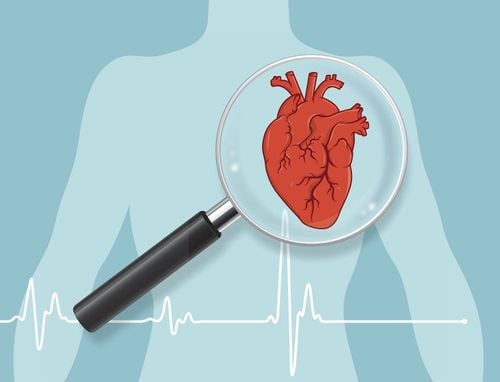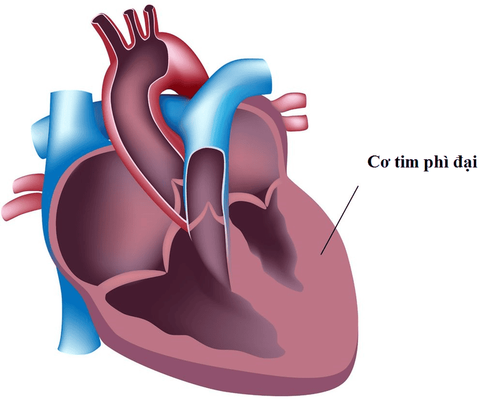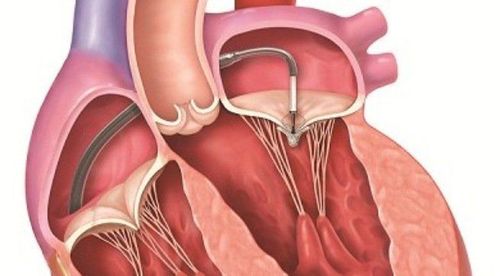This is an automatically translated article.
The article is professionally consulted by Master, Doctor Bui Tien Dat - Emergency Medicine - Cardiology - Emergency Resuscitation Department - Vinmec Hai Phong International General Hospital.Aortic stenosis is one of the four most common types of heart valve disease and has a serious impact on patients' health. It interferes with the flow of oxygen-rich and nutrient-rich blood to other organs in the body. If not detected and treated promptly, the disease can cause dangerous complications, threatening the patient's life.
1. What is aortic valve stenosis?
Aortic stenosis is a condition that occurs when the aortic valve does not open completely, causing the opening between the left ventricle and the aorta to narrow. At this point, the heart will have to work harder to pump blood through the smaller hole, causing the ventricular chambers to dilate, the wall of the ventricles to thicken, and the heart to weaken.The narrower the valve, the harder it is for blood to pass, the amount of blood that is not pushed into the artery lumen will be stasis in the ventricles, causing severe anemia, hindering the blood supply to the organs in the body. body of the aorta.
In certain cases, aortic stenosis occurs at the same time as aortic regurgitation.
2. Signs and symptoms of aortic stenosis

Angina : The chest is heavy and tight, the pain may be spread to the jaw, neck, or hands. Coughing, even coughing up blood Lightheadedness, fainting or unconsciousness Signs of heart failure, such as feeling short of breath, body fatigue, exercise exhaustion, sometimes waking up in the morning midnight sudden weakness in the limbs, vision problems, high fever, bleeding at the surgical site, depending on the location of each person, the condition of the disease will be different. Some patients have no symptoms at all.
3. Causes of aortic valve stenosis
Some of the main causes of aortic stenosis include:3.1 Congenital heart defect This birth defect is caused by an abnormality in the structure of the heart valves at birth, such as the mitral valve. Over time, this condition will cause the heart valves to narrow and degenerate.
3.2 Calcification or cholesterol plaques in the heart valves As age increases, the aortic valve becomes calcified, causing serious cardiovascular problems, including aortic stenosis.
3.3 Rheumatic fever This is a serious complication of pharyngitis. This complication can cause major damage to the heart valves and lead to heart failure. In addition, rheumatic fever also forms scar tissue in the aortic valve, making the valve narrow and creating favorable conditions for calcified plaques to easily accumulate.
3.4 Due to rheumatic fever Rheumatic heart disease accompanied by mitral valve disease, rheumatic heart disease causes calcification, fibrosis, adhesions of the valve edges and leaflets of the aorta.

4. Subjects often have aortic valve stenosis
Currently, aortic valve stenosis is one of the most common diseases. Statistics show that in men, especially those with advanced age, the rate of aortic valve stenosis is three times higher than that of women.4.1 Factors that increase the risk of aortic stenosis The following factors can increase the risk of aortic stenosis:
People who are born with aortic stenosis, or progress to development of mitral valve status. Mitral valve disease can be inherited if someone in the family has the disease. Aortic valve degeneration The older you are, the more likely you are to have calcium deposits in your heart Rheumatic fever Have chronic kidney disease Some other risks such as diabetes, high blood pressure, smoking, cholesterol levels high in blood. 4.2 Is aortic valve stenosis dangerous? When the aortic valve is narrowed, it puts pressure on the left ventricle. To accommodate this situation, the heart responds by hypertrophy of the left ventricular myocardium. If this condition goes on for a long time and is not treated in time, it can lead to mitral regurgitation, then heart failure, seriously affecting the patient's quality of life such as frequent shortness of breath, fatigue, exhaustion, fainting even sudden death.
In the early stages, the disease will progress silently, but when symptoms appear, the risk of death will skyrocket rapidly. After 2-3 years, only 50% of patients are likely to survive.
5. Diagnosis of aortic valve stenosis
To diagnose aortic stenosis, a doctor may ask a patient to fully describe their symptoms, as well as their personal and family medical history. A number of tests and laboratory tests are performed to help the doctor determine the condition and extent of damage to the valve. Includes:Electrocardiogram: Helps detect left ventricular hypertrophy and left atrial hypertrophy. This is the most common consequence of aortic stenosis. Chest X-ray: Assess the condition of the chest and surrounding areas. Doppler echocardiography: This is the leading method to diagnose and evaluate the severity of aortic stenosis. This test is usually indicated when the clinical examination has a heart murmur or other symptoms suggestive of disease. Cardiac catheterization: This method is performed when other tests are not sufficient to evaluate or coordinate to increase the accuracy of the diagnosis. Exercise testing: Indicated for asymptomatic patients, it provides additional useful information for the diagnosis of aortic stenosis.
6. Treatment of aortic valve stenosis

You can use medicine for treatment as prescribed by your doctor. However, in cases of severe narrowing and already showing symptoms, surgery should be performed as soon as possible. Delay increases the risk of surgical complications and sudden death.
Here are some treatments for aortic stenosis:
6.1 Medications Doctors may prescribe medications to patients to help limit symptoms and prevent heart failure. These drugs include beta blockers, calcium channel blockers, antiarrhythmics or anticoagulants, etc. In addition, some antibiotics can also be used for cases of valve stenosis due to stenosis. rheumatic heart disease to prevent the risk of endocarditis and myocarditis.
6.2 Treatment of percutaneous balloon dilatation This method is mostly applied to children, elderly people who cannot perform valve replacement surgery or for temporary intervention while waiting for valve replacement.
6.3 Open valve replacement surgery This is a relatively safe treatment and has a high success rate. However, the service life of the valve and its influence depends more or less on the location as well as the adherence to treatment of each patient. Your doctor may order you to replace the following types of valves:
Biological valves : For people over 70 years old with weak health. Although these valves do not require long-term anticoagulation, their lifespan is quite short and can cause complications such as valve regurgitation or stenosis within 10 years. Mechanical Valve: This type of valve is made of metal and has a long service life. However, patients will have to take anticoagulants for life to limit the risk of blood clots and other thromboembolic complications.
7. Prevention of aortic stenosis

Follow a healthy, low-fat diet and increase vegetables and fruits Exercise Regular exercise helps maintain a healthy physique Quit smoking Limit the use of stimulants such as alcohol Clean teeth, regularly visit a doctor to detect and treat strep throat early, help increase the risk of rheumatic heart disease. Strictly follow the treatment regimen and should monitor possible complications during treatment to promptly notify the doctor. Should limit eating foods high in potassium such as bananas or dark green vegetables. if you use anticoagulants so as not to affect the effect of the drug). It is advisable to have regular health check-ups to monitor valve stenosis as well as early detection of abnormalities. Currently, at Vinmec International General Hospital, open-heart surgery is a very popular surgery, treating many cardiovascular diseases. More specifically, at the 43rd World Anesthesia Conference in New York, Vinmec announced the success of open heart surgery without morphine pain relief, combined with the use of new regional anesthetic technique ESP. This has helped hundreds of patients get rid of the pain after surgery as well as the side effects when using morphine such as: long recovery time and hospital stay, nausea, vomiting, itching, respiratory failure, etc. dependent, thereby causing pain syndrome, chronic pain after surgery.
Master. Doctor. Bui Tien Dat received intensive training in the field of cardiology and cardiovascular emergency resuscitation at Hanoi Medical University and Bach Mai Hospital. The doctor has more than 12 years of experience in the field of emergency and cardiovascular resuscitation and is currently a doctor at the Emergency Department of Vinmec Hai Phong International Hospital.
Please dial HOTLINE for more information or register for an appointment HERE. Download MyVinmec app to make appointments faster and to manage your bookings easily.
Article referenced source: patient.info













